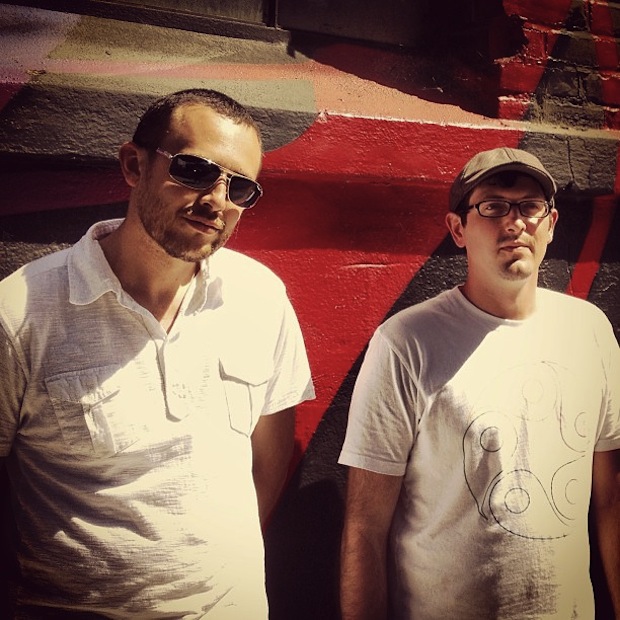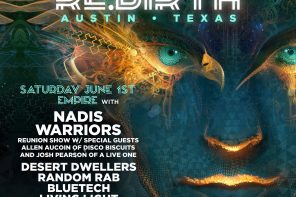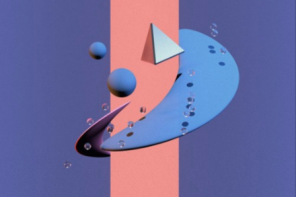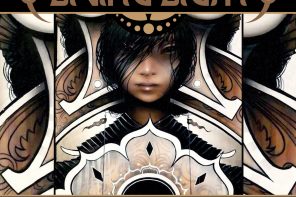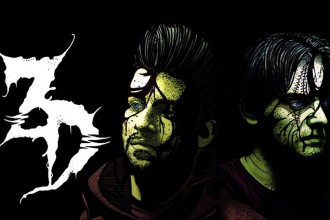The producer/drummer combo couldn’t get more dialed in than the amorphous shape shifters of Aligning Minds. We linked up with Mike Folk and Daniel Merrill, the producers behind this unique trifecta to discuss their remix contest, the new album, production flow, life on the road, their primordial percussionist Matthias Sayour and the future of Aligning Minds. In a little over a year, we have watched this east coast bass triplet grow from the side stage at Gnarnia, to their all systems go main stage performance at Gratifly Music & Arts Festival. Alongside this interview, they are releasing an hour long live set recorded at the 9:30 Club in DC from their tour with Papadosio, which includes six unreleased tracks and a promo video that highlights a few of the shows on their My Heart is Love tour.
Click HERE for more info.
[LiS] Your newest release. Tell us more about it – what is its premise and what are the feelings involved?
[Mike] The newest release is our second LP, entitled My Heart Is Love, which was released on Jan. 29th, 2013 on Gravitas Recordings. I would say the premise has a lot to do with acceptance, forgiveness, letting go of the past and opening one’s self up to life, the world, and the universe. It’s about surrender, and flowing with intuitive, creative energy. It’s a daily discipline to do so, and we just wanted to put something out that reflects that lesson – and also sums up where we’ve been, where we are and where we’d like to go. I’d say in comparison to Universal Automation, it’s similar in ways but also pretty markedly different… There’s a lot of soul.
Tell us a bit more about Gravitas Recordings and where we can get the album?
[Dan] The new album is currently a digital only release through Gravitas Recordings, based in Austin, TX. It’s available directly from the bandcamp page @ http://music.gravitasrecordings.com/album/my-heart-is-love-2 or through all major online digital distributors like Itunes, Beatport etc. Our first full length Universal Automation came out on Aleph Zero Records, sub label Beats and Pieces, which is based in Israel. This time around we wanted to release with a U.S. based label and hit more of our home market, but also go with a label that really embraced diversity and how we wanted the album to come out. Gravitas has their ears well-tuned to the U.S. bass music scene, which we touch upon – but they also embrace eclecticism and experimentation, so it balances well. We definitely like to mash-up lots of influences and vibes, and they really welcome that.
Gravitas Recordings has put together a remix contest for fans of the album, called ‘My Heart is Remixed.’ Can you tell us about that?
[Dan] They’ve done a couple of remix competitions in the past, which have done really well and created alot of synergy between the fans, the producers and the label. We all thought it would be a good idea to do one for the album, as it’s inspiring to see everyone getting involved and hear the results! We decided to make the stems of three tracks from the album available – “A Noble Truth”, “Weeping Willow”, and “My Heart is Love.” We wanted people to have the option to pick which track(s) inspired them and rework it. We’re also offering an array of prizes to the winners, including a release on our upcoming official remix album on Gravitas, plugins from 2CAudio and Izotope, a Keith McMillen QuNeo, prints of the album artwork by Mugwort Designs, an exclusive hoodie designed by Original Language, Soundcloud Pro accounts and more… The deadline for submissions is Sept. 30th, when we’ll pick a grand prize winner and runners up. Plus we get to play out all the dope remixes in our upcoming sets! The stems and all the info can be found here.
You are also releasing an hour long live set and promotional video alongside this feature – would you like to give a little background on those?
[Mike] The live set was recorded at the 9:30 club in Washington, D.C. on April 19th, 2013. This was one of the four dates of the tour we did with Papadosio, which was a leg of the My Heart is Love tour. Featuring the live rhythms of Mathias Sayour on drums, and played for a massive crowd, this set showcases a selection of music that appeared on the album as well as some remixes and unreleased exclusives. It’s a set we’ve been developing for some time and are excited to finally share and give a little taste of the things we’ve been working on. Alot of the unreleased material in this set is actually older, and I think for alot of people that haven’t heard us live in the past year, it will be a great introduction to how our live sets are evolving with the inclusion of Matthias on drums. The promo video was shot during another leg of the My Heart is Love tour with Desert Dwellers and David Block. Additional footage towards the end is from the show with Papadosio at The 9:30 Club in Washington, DC. Both the live set and the video are very special to us and really showcase what we are doing in the live realm; We’ve been hitting the road hard this past year… There are still alot of people and fans around the world that haven’t gotten the chance to see us in a live setting, so it’s very exciting for us to be able to share a piece of that experience with them.
Describe the workflow/process you use to create an Aligning Minds track.
[Dan] Well, it varies from time to time, to keep things interesting, but… As with most people, we usually start with a solid beat. It’s all about creating that skeleton frame on which to add the body. So, creating/refining a basic rhythm to get a groove going – with just enough details to keep it interesting to continue the writing process, but still leaving plenty of room for new ideas to emerge. Then, a mood is set. This could just be a particular sample, pad sound, vocal snippet, whatever – just something, anything that grabs your imagination and creates an emotional space. Then it’s just all about telling a story within that mood-environment.
Usually that starts with a melody that elaborates on that mood, followed by a bassline that harmonizes with it… Then maybe more percussion parts to make it groove, and then, usually by that point… A hypnotized state takes over. I think a lot of times when people explain their process, the literal, technical process can be explained to death – but this selfless state is the most important step to mention. It’s also the most fascinating, because it’s at this point that you’re communing with a force greater than the sum of its parts and following your intuitive guidance system. It seems that if you’re not getting lost, infatuated, emotionally helpless to the sound… You need to keep trying new things until you do. Honestly, once this state really sets in, a lot happens that can’t even be recollected, as the rational mind takes a back seat. But for the sake of answering this question properly, once these elements are in place, and we’re transfixed by the emotional space that’s been carved out, variations and elaborations are created. So we’ll maybe take one element that’s working, and isolate it from the rest – and then write 3-4 new elements that go with that, and repeat that process a number of times.
This results in a bunch of parts that tell a story together – different phrases, melody lines, rhythmic changes, fluctuations in energy. Some of them work together better than others, but they aren’t to be judged while being written. It’s important to just write what is felt. Then that gets narrowed down to what’s really working and essential, and what isn’t (but might be better used in a different tune.) Then, the arrangement starts, allowing the energy to build/release and progress over time. A lot of the mixing is done as part of this process too, just getting each part to speak its voice properly in the arrangement. Then, effects/automation, re-sampling, re-interpreting what has been written, and finding interesting ways to make one element play various roles in the arrangement, etc. Sometimes the arrangement emerges easily; Other times there are many versions, and it’s a time consuming, narrowing-down process. When the arrangement is mostly there, the fundamental mixing is done, etc – then the earcandy/post-production stuff takes place. Often a lot of these layers are just really subtle embellishments on what’s already there, but sometimes they turn into complete mutations of the original content, inspiring new directions for the arrangement. We often like to take the original, overly ‘clean’ ideas and make them weird, imperfect and organic. Adding character in various ways to bring out the nuances and give them more life. It can be tricky to keep this element in check – not just adding more and more detail to keep us interested (after hearing the track zillions of times) – but actually adding detail that isn’t dead weight. Then, we try to not get completely obsessed with it so we can get on with our lives.
What gear do you use in the studio?
[Dan] We live in different states, and therefore each have our own studios, but we’ve always maintained a nearly identical setup – which is pretty simple really… Laptops running Ableton Live, Native Instruments audio interfaces, Akai APC 40’s, Novation Remote SL’s for keys, MPD 24’s, field recorders, a couple of mics for recording vocals, live instrumentation, etc. Most of the diversity and control is in using a fair amount of plugins; Everything from freeware to NI, Fabfilter, Waves stuff. We’ve always been pretty addicted to vst nerdery. To give you a brief idea of some instruments – REAKTOR, reaktor, reaktor, anything Rob Papen, Consequence, Camel Audio Alchemy, uHE, Harmor, Psychic Modulation Aetheral, Microtonic stuff, Gladiator, the whole gamut of Native Instruments stuff, Spectrasonics. Effects: (too many to list) – 2CAudio Aether, Camel Space, Waves – especially JJP, Ekramer, CLA, Maserati, API – Sonnox Oxford, Saffire, Melda, Brainworx, Sonalksis, Fabfilter, Antares, Speakerphone, Sugarbytes stuff, Twisted Tools Rolodecks, Izotope Stutter Edit, Effectrix, Dblue Glitch, Tornado, Replicant, livecut.
You have several different live formats. How does your live setup work with two producer/DJ’s and a drummer?
[Mike] Our live shows come in several flavors and are kind of modular in the respect that we can adapt the configuration according to the budget of the show, location and personal scheduling between the three of us. The typical configurations are – Solo – which is either me or Dan performing an all original live set, Duo – which is both me and Dan performing live together (which usually entails us being synced up and either of us taking the lead at specific points in the set while the other one adds in additional components, live keys, bass, textures, atmospheres and loops.) There is a lot of live effect manipulation and signal processing, and generally we just having fun manipulating earcandy elements, while the main chunk of the tracks are played out. Finally, we have the trio configuration which is both of us as well as Matthias on live drums. We are constantly working on new setups and configurations, but generally speaking me and Dan do our thing just as we would as a duo while Matthias locks in and takes the rhythm / drum components to a whole new level. He keeps his kit setup simple, incorporating some live electronic drum pads and some more organic instruments like chimes. He just focuses on driving the energy to a new level by playing in and around the main rhythmic components of the tracks, which in turn frees us up to focus on more live effect / sample manipulations and sound sorcery. When we play with Matthias, we tend to focus on our material that is more beat oriented and straightforward. We usually save the more abstract and mathematical stuff for our personal sets, as a lot of it is quite hard to replicate on a kit.
Your drummer is an animal – what’s his deal?
[Mike] Best described as a neo-mechanical beat shaman simultaneously balancing the ancient tribes with the future, he comes equipped with healing powers and permanent tempo lock. We met Matthias at a small festival outside of Asheville in the summer of 2011 called Welcome to Pangea. During the daytime Aligning Minds set, he was getting down in a very unique and deliberate way, notedly kneeling on the ground wailing away on a practice drum pad throughout parts of the set and practicing various meditative/yogic poses at other points. He seemed to really connect with the set in a very deep and passionate way. After the set was over, he approached us and introduced himself as the drummer for Chronicles of the Landsquid, which is another producer/drummer combo he’s involved with, that features the production prowess of Pericles. He said he would love to talk afterwards and ideally get some of the material that was played for his own personal enjoyment. We ended up talking and connecting and decided to discover if there was indeed some interpersonal alchemy to explore. We sent him over a chunk of material and a few weeks later went over to his house, which I might add, is a brilliantly peaceful little haven nestled in the Blue Ridge Mountains. He had already spent days honing the drum parts for a few of the tracks and proceeded to completely redefine the way I heard one of our currently unreleased tunes “Zeke” (which is in the live set that is being released alongside this interview.) As soon as he started playing, I knew we had found our drummer. His focus is on accentuating rhythms and adding to the overall structure rather than solely creating it, which in my experience is a very rare thing to find in a drummer. He really is a machine and prefers to play with quantized music, as he enjoys the challenges involved in enhancing precise electronic grooves. He has an intense focus on health, exercise, meditation, diet, inversion, stretching and overall well being. All that brings a lot of balance to our crew especially when we’re on the road. An absolutely essential addition, and we are beyond grateful to have him on board and moving forward into writing more material with him from the ground up.
Tell us a bit about the Asheville music scene.
[Mike] The Asheville music scene is simultaneously beautifully abundant and rarely sparse. We have a treasure chest of very talented producers and musicians that range all styles. Along with a nice foothold in the music industry with the Moog Factory/Store downtown along with various other modular synth, software development, instrument manufacturing companies like Make Noise, who make some of the most brilliant modulars out there right now. You wouldn’t think that a small little mountain town would hold so much nerdery, talent and love for electronic mediums, but the balance of nature and progressive outlooks seem to create a recipe for neo-shamanic seekers (modern hippies), which translates very well to our fanbase. We’re really excited to be playing Asheville’s first Mountain Oasis Music Festival in October alongside some of our favorite artists such as Nine Inch Nails, The Orb, Ulrich Schnauss, Bassnectar, Animal Collective, Pretty Lights and Mount Kimbie just to name a few… Then in April of 2014, Moogfest will be debuting its new direction, which will be curated by Paxhau who also throws and curates the Detroit Electronic Music Festival.Definitely feeling very blessed to be based out of Asheville. It’s amazing that we’ll have two major electronic music festivals for a city of this size. It’s an honor to help foster the scene here and push things forward. For those of you in Asheville, be on the lookout for our next installment of XAVL (http://www.xavl.org) on November 9th, which we are working very hard on to ensure that it is taken to the next level.
What got you into electronic music?
[Dan] We both came from the same area which was very rural, and there wasn’t a lot to do. Music was a much needed positive outlet. Metal was the obsession then, which led to industrial music that incorporated electronics, which led to an overwhelming fascination of the infinite possibilities within electronic music. I remember just personally feeling really discontent with the guitar, feeling like it was capable of only a certain range of sounds (although vast and infinite in its own right), and feeling limited… And then just feeling incredibly excited about the discovery of synthesizers. That feeling kept building, with a perpetual sense of personal evolution with the music. There was a sense of personal growth, exploration and consciousness expansion. Of course the psychedelics didn’t hurt either. But finding music that was really open, positive, exhilarating, fresh and captivating – that spoke to a more spiritual nature – was obvious that we had found our calling. We both set out to learn production pretty immediately, and interestingly enough, years before we made it to an event. Raves, festivals, clubs – none of that was in our understanding then. We just loved the music itself, and nothing else mattered. Fascination became obsession really, and the rest is history.

What have been your main influences?
[Dan] So many artists and sounds have influenced us both, together as collaborating artists but also independently. So listing artists probably won’t paint a clear picture. I’d say we’ve been influenced by broad but distinct aesthetic tastes, independent of any one genre, artist or sound… Those general tastes revolve around moody, melodic, emotional, personal, ethereal sounding music. So that takes many, many forms obviously. Therefore we’ve been heavily influenced by everything from acid jazz and ambient to world music and bossa nova… But to get a little more specific, we were initially really influenced by lots of IDM AND dance music, and everything in between that was deep and immersive, or just caught us by surprise.
Of course we really followed the output of labels like Warp Records, Ninja Tune, Merck, City Centre Offices, Monotonik just to name a few – tons and tons of IDM – but also everything from deep/progressive house and techno, deep drum n bass, breaks, trip-hop, downtempo and glitch-hop. To throw out some names, artists like Aphex Twin, Luke Vibert, Boards of Canada, Autechre, Plug, Clark, Sasha, Leftfield, Orbital, Underworld, Tipper, Polar, Klute, Bluetech, Shpongle, Edit, Telefon Tel Aviv, Funkstorung and so on. The point is, we were all over the place. And yet, we weren’t involved with any one sound or scene in any way, we just took everything we liked and went and made tracks that incorporated all of those influences. That’s what made it so interesting to us – anything was possible. Rules were there if you wanted to achieve a certain style but could be easily discarded when you got tired of them. So we loved taking the experimentation and just plain strangeness of IDM and fusing it with the hypnotic qualities of more groove-driven music. It just had to be deep, unique and make us feel something new and powerful.
What is your view on the state of music industry and its relation to free music and piracy?
[Mike] We grew up right on the cusp of the whole file sharing movement. mIRC and the demoscene was a part of growing up. Living in the middle of an isolated area with very little outside influence, it didn’t take us long to realize that various forms of information were freely available online at the cost of a few keystrokes. We chose very early on a path of self education and discovery. That whole movement played a huge role in the current understanding of our skillsets and our ability to create the reality that we were envisioning.
As we grew older, we realized the importance of compensation and contributing to the artists work that inspired us. I think the current state of the music industry is one built on middlemen and penny snatchers. It’s setup to reap its own profit off of other artists work. However, being that there is a massive undercurrent of possibilities and technologies that allow artists to distribute their music on more of their own terms, I think we live in a DIY world, and it’s each artist’s responsibility to seek out solutions that work with the model that they are trying sustain. It’s more about an equal energy exchange. If our work inspires you, I feel that it’s your responsibility to give back what you can in whatever format you feel is most relevant to your current situation. Money is the easiest way to contribute back to artists as it is a necessity and can be easily disseminated, but do your best to give it in a way that directly supports the artist and their efforts. If you’re unable to give anything else, remember that social media likes and shares really do make a difference for artists these days. As performing artists we work inside a system that takes hype factor at face value. As a general rule of thumb, promoters, labels and investors take an artist’s social media reach very seriously. It’s a bit of an unfortunate situation as it often seems like the focus isn’t on musical quality as much as it is about the hype factor and marketing appeal. The bottom line is, if something inspires you on any level – GIVE BACK. Buy the music, share it, go to shows, contact your local promoters and ask them to book an artist. Whatever it is, try and do something because every little bit goes a long way to help create sustainability for the artist.
Where does the name of your project come from?
[Aligning Minds] As with everything else, mostly from intuition. We were walking in a deep, dark pine forest one day, talking about our vision and one of us (can’t remember who it was now) said “what will we call it?” – “um…Aligning Minds?… Like, in the act of aligning minds, creating unity through sound? Yeah, that’s it.” Done.
You have been touring across the nation and in Canada in support of the album. How has that been, and what are some of the upcoming dates and locations?
[Dan] We’ve had some amazing times. The support people have shown the album has been truly inspiring, and it’s been an honor to be able to share it with people, in person. We made it over to the west coast twice during this tour. The first time was in April, and it was the two of us, and the second was in June and was just Mike on his own. But I can safely say that the west coast showed us big love – Flagstaff and San Diego were two of our favorite spots. Amazing crews of people out there, and beautiful vibes.
[Mike] Too many amazing events and experiences to really convey in words. As Dan mentioned, the second trip out to the West Coast I did solo. The first half of the run, I traveled with my good friend and fellow RE:Evolution artist Futexture (David Krantz), and we had quite an adventure. While I was out there the second time I played False Profit’s Priceless festival, which was absolutely incredible – intimate, sophisticated, a beautiful locale, and an unbelievably stacked lineup – a true gem. I highly recommend going if you ever get the chance. Then we bounced up to Eureka, CA, and then up through Portland/Seattle, played The Luminosity Festival in British Columbia, which was a highlight of the summer for sure. That run was topped off by the Photosynthesis Festival in Neah Bay, WA. Drumspyder ended up sitting in on my set and doing live hand drums, which was a nice spontaneous treat. After that I headed back east, and we played a string of shows on the east coast, of which Pex, Gratifly and Rootwire were definitely highlights. Other legs of the tour included are a tour with Papadosio, a small tour with Desert Dwellers and David Block and several shows with Phutureprimitive/ill–Esha, and coming up in October we will be hitting the road with Ott. as well as playing the Mountain Oasis Music Festival. We are slowing things down a bit show wise this fall/winter to get back in the studio and finish our followup album, which isn’t all that far away, along with the remix album that will be dropping in October. Some upcoming dates to note:

